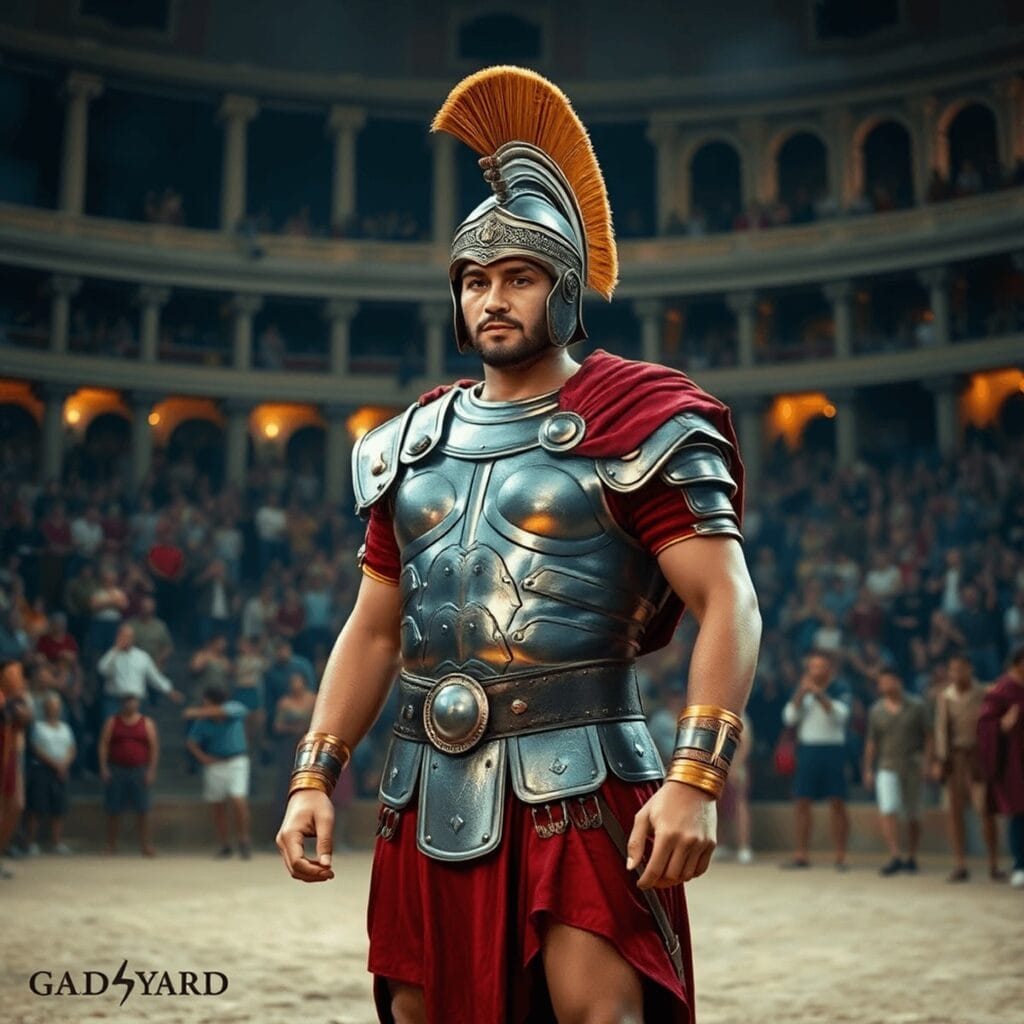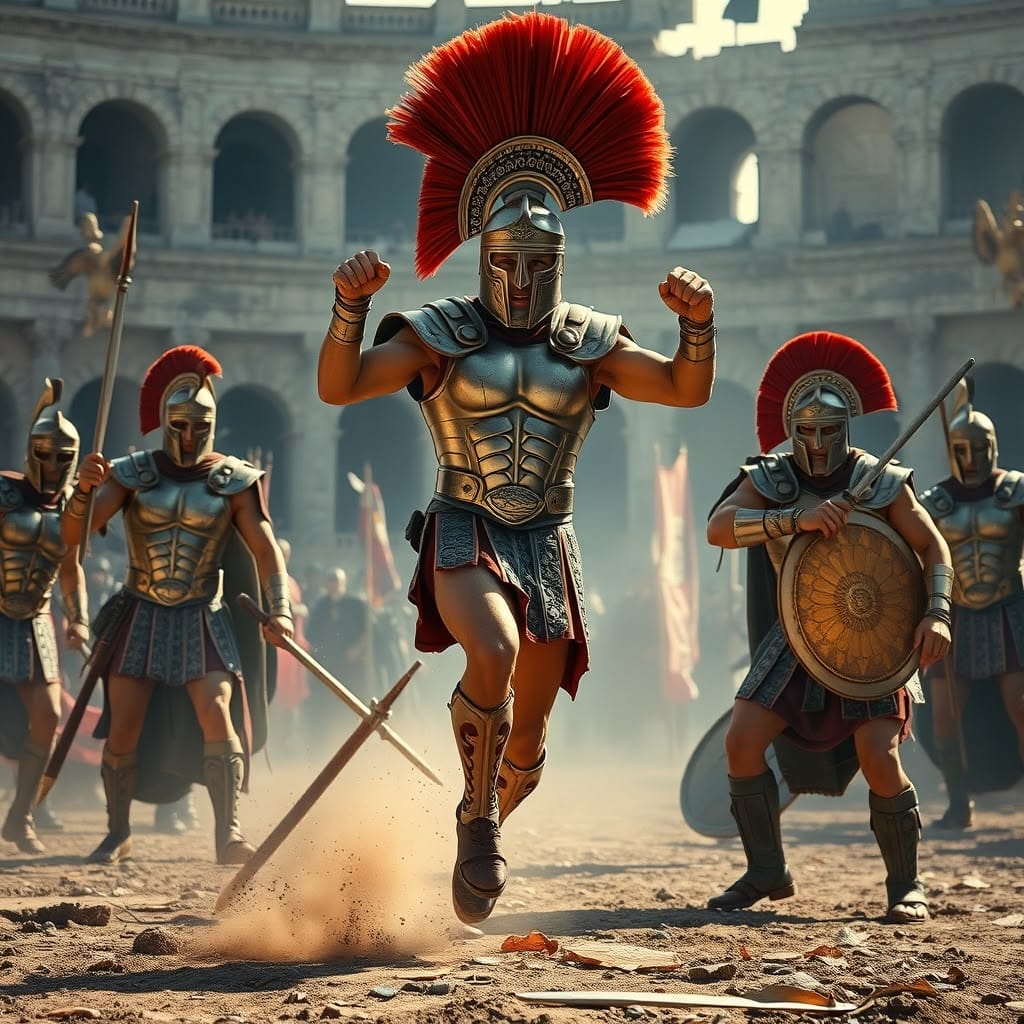Roman gladiators were not just brutal fighters; they were highly trained athletes whose preparation was a cornerstone of their survival in the arena. Understanding Roman gladiator training techniques offers valuable insights into their physical prowess and the fierce nature of their battles.
The training of these gladiators was a significant aspect of the broader spectacle of Ancient Rome, which included not only gladiatorial combat but also chariot races and theatrical performances. This involvement wasn’t just for fun; it had significant effects on social relationships and political authority. Exploring these techniques sheds light on the intricate balance of discipline, strategy, and entertainment that characterized the life of a gladiator. The legacy of their training continues to influence modern fitness practices today.
For more insights into the fascinating world of Ancient Rome, including its social class divide, notable historical figures like Scipio Africanus who changed the course of history, or an in-depth exploration into the ancient Roman religion, visit Men of Pompeii, your ultimate online resource dedicated to bringing the past to life.
The Structure of Gladiator Training
Gladiators underwent their training in specialized institutions called Ludus Gladiatorius. These schools were specifically designed to provide a demanding training environment where aspiring fighters could refine their combat abilities and improve their physical fitness.
Facilities and Supervision
The key elements that made these schools effective included:
- Facilities: They had arenas for practice fights, workout areas for strength training, and designated spaces for weapon exercises.
- Supervision: Experienced instructors, often former gladiators themselves, conducted the training sessions, ensuring that each gladiator received individualized guidance.
The Role of Owners
The owner played a crucial role in shaping the training process. Owners, known as lanistae, provided financial support and made important decisions regarding:
- Training Regimens: They established specific workouts tailored to the strengths and weaknesses of individual gladiators.
- Management: Owners oversaw the daily operations of the school and enforced discipline among the trainees.
Types of Gladiators
Gladiators were classified into different categories based on their fighting techniques and weapons. Some common types included:
- Murmillo: Heavily armored with a sword and shield.
- Thraex: Featured a curved sword and small shield for agility.
- Retiarius: Utilized a trident and net, emphasizing speed over armor.
This organized approach ensured that every gladiator received training not only in combat but also in entertaining the bloodthirsty crowds of ancient Rome.
The Tetrad Training Regimen
The Tetrad regimen was a fundamental training structure that gladiators followed, consisting of four distinct phases:
- Preparation: This phase involved short, intense movements designed to warm up the body and prepare it for rigorous activity.
- Trial: Gladiators engaged in all-out tests of their physical limits, pushing their endurance and strength to the max.
- Rest: A period of moderate activity allowed for recovery while maintaining some level of engagement in physical training.
- Skill Development: Focused on mastering specific combat techniques, this phase incorporated various drills to enhance fighting skills.
The cyclical nature of this four-day cycle provided several benefits:
- Improved Physical Conditioning: Alternating between high-intensity workouts and recovery periods ensured that gladiators built both strength and stamina effectively.
- Skill Acquisition: Regular practice of techniques during the skill development phase enabled gladiators to refine their combat skills steadily.
This structured approach not only prepared them for the challenging battles ahead but also contributed significantly to their overall performance in the arena. Such rigorous training was essential in an environment where survival depended on one’s ability to adapt and excel, much like the broader societal changes experienced during the transition from monarchy to a republican system in Rome, known as the birth of the Roman Republic.
Moreover, the discipline and resilience cultivated through such training have parallels in various aspects of modern society, including the enduring influence of the Corpus Juris Civilis on modern law, which serves as a testament to Rome’s lasting legacy. Additionally, elements of Roman mythology continue to influence modern culture, showcasing the multifaceted impact of ancient Roman civilization.
Physical Conditioning Techniques
Gladiators, like the plebeians who were the common people of Rome, relied heavily on bodyweight exercises to build strength and endurance. These qualities were crucial for their survival in the arena. The movements they practiced became the core of their training routine, enabling them to develop functional fitness specifically designed for combat situations.
Key Bodyweight Exercises
Some of the key bodyweight exercises that gladiators focused on included:
- Push-ups: These exercises helped strengthen their upper body and core, which were essential for delivering powerful strikes and executing grappling techniques.
- Sit-ups: By performing sit-ups regularly, gladiators could develop their abdominal muscles, leading to improved stability during fights and better control over their movements.
- Lunges: This exercise targeted leg strength and balance, both of which are vital attributes for swift movement and effective evasion in combat scenarios.
Incorporating these exercises into their daily routines allowed gladiators to achieve peak physical conditioning. The emphasis on functional strength through bodyweight training fostered an athleticism that complemented their weapon mastery. The rigorous training not only built muscle but also enhanced endurance, preparing gladiators for the grueling demands of battle. This foundation of physical prowess laid the groundwork for further skill development as they honed their combat techniques.

Mastery of Weapons in Gladiatorial Combat
Gladiators were trained to wield a variety of weapons, each requiring distinct techniques and skills. The primary weapons included:
- Swords: Different types such as the gladius, a short sword favored for its thrusting ability.
- Shields: Used not only for defense but also for offensive maneuvers, allowing gladiators to push and strike enemies.
- Tridents and Nets: Unique to certain gladiator types, emphasizing both agility and strategy.
Weapon mastery was crucial for survival in the arena. Gladiators practiced extensively to refine their combat techniques, focusing on two main categories:
- Stabbing Techniques: These involved quick thrusts aimed at vulnerable areas, maximizing damage with minimal exposure.
- Slashing Techniques: While powerful, slashing required more space and timing, making it riskier during close combat.
Regular practice with wooden replicas allowed gladiators to develop muscle memory and precision. Training ensured that they could respond instinctively in high-pressure situations, leading to a higher chance of survival against opponents. Mastery of these combat techniques transformed gladiators into formidable warriors, capable of adapting their strategies based on the weapons they wielded.
The brutal nature of gladiatorial combat, highlighted by the rigorous focus on weaponry, was a testament to the skill level achieved through dedicated training. This aspect of Roman culture is just one part of the broader tapestry of incredible Roman engineering feats that changed the world, showcasing their capacity to connect far-flung regions and ensure effective governance and cultural exchange. Such engineering prowess served as a foundation for contemporary infrastructure systems, illustrating the lasting impact of Roman innovations beyond the arena.
Hand-to-Hand Combat Techniques for Gladiators
Gladiators were not solely reliant on weapons; mastering hand-to-hand combat was crucial for survival in the arena. Two primary disciplines included:
1. Wrestling
This skill focused on grappling techniques, allowing gladiators to control opponents through holds and throws. It emphasized strength and leverage, enabling a fighter to disable an opponent even when disarmed.
2. Boxing
Gladiators trained in striking techniques that involved powerful punches and defensive maneuvers. Boxing skills complemented their weapon training by enhancing speed, reflexes, and the ability to evade attacks.
Incorporating these grappling and boxing techniques into their training provided gladiators with a versatile skill set. They learned to adapt their fighting style based on the circumstances of combat, ensuring they could handle various scenarios in the arena. This comprehensive approach helped gladiators maintain dominance over their adversaries while showcasing their prowess to spectators.
Despite their skills and bravery, the life of a gladiator was complex, straddling the line between admiration and victimhood within Roman society. For a deeper understanding of this duality, you can explore more about the fascinating role of gladiators in Roman entertainment.

Functional Training Methods for Gladiatorial Combat
Gladiators employed various functional training methods to enhance their performance in combat. Two key components of this training were agility drills and plyometrics.
1. Agility Drills
These exercises focused on improving speed and quickness, essential traits for surviving in the arena. Gladiators practiced footwork patterns, directional changes, and reaction time drills. Common agility drills included:
- Ladder drills
- Cone sprints
- Shuttle runs
These activities allowed gladiators to navigate the arena with finesse, evade attacks, and position themselves advantageously against opponents.
2. Plyometrics
This explosive training method played a critical role in developing power for striking and evasive movements. Plyometric exercises involved rapid stretching followed by immediate contraction of muscles, which enhanced explosive strength. Examples included:
- Box jumps
- Depth jumps
- Medicine ball throws
Through these dynamic movements, gladiators increased their ability to deliver powerful strikes while simultaneously enhancing their capacity to dodge incoming threats. The combination of agility training and plyometrics created versatile warriors capable of executing complex maneuvers under pressure, ensuring they remained formidable opponents in the arena.
The training methods used by gladiators were not just about physical prowess; they also reflected the broader military might of the Roman Empire. For instance, the Roman Army, known for its structure and operational effectiveness, played a crucial role in shaping the empire’s growth and maintaining its vast territories.
Moreover, the architectural feats achieved during this period, as seen in Roman architecture, were a testament to the innovative spirit of the Romans. These structures served not only functional purposes but also stood as symbols of power and cultural identity.
Furthermore, the principles laid down by Roman law have significantly influenced modern legal systems. Understanding this legacy is essential for grasping the foundations of contemporary laws.
Lastly, it’s important to note that societal structures such as those represented by the patricians, who were masters of Roman luxury and power, played a significant role in shaping the socio-economic landscape of ancient Rome.
Technique Practice Tools Used by Gladiators
Gladiators employed various practice tools to refine their combat techniques, ensuring they were battle-ready. Among these, punching bags were a staple in their training regimen. These bags served multiple functions:
- Striking Techniques: Gladiators practiced their punches and kicks, developing power and precision.
- Footwork Patterns: The movement around the punching bag improved agility and quickness, simulating real combat scenarios.
Other equipment included wooden swords and shields. These replicas allowed gladiators to hone their striking techniques while gaining familiarity with the weight and balance of actual weapons.
Incorporating drills with these tools helped gladiators enhance their combat skills effectively. The rigorous practice not only focused on strength but also aimed at refining technique under pressure, preparing them for the brutal realities of the arena.
Recovery Practices Post-Training for Gladiators
Recovery played a crucial role in the rigorous training regimens of gladiators. Effective recovery methods were essential to prevent injuries and promote adaptation after intense physical exertion. Key aspects included:
Bath Complexes: Gladiators frequently utilized public bath complexes, which served as relaxation hubs. These facilities offered hot and cold baths that helped soothe sore muscles and aid in recovery.
Rest Periods: Scheduled rest days allowed gladiators to recuperate physically and mentally, ensuring they remained at peak performance levels.
Massage Techniques: Skilled attendants often provided massages to alleviate tension and improve circulation, contributing to faster recovery.
Nutritional Support: Post-training meals rich in carbohydrates and proteins facilitated muscle repair and replenished energy stores.
Incorporating these practices into their routines ensured that gladiators could endure the demands of their training while maintaining optimal physical condition for combat.
Nutritional Strategies for Optimal Performance as a Gladiator
The diet of a Roman gladiator played a crucial role in their training and performance. Understanding the nutritional strategies they used reveals how these warriors sustained their intense physical regimen.
1. Carbohydrates: The Energy Source
Carbohydrates were the main component of a gladiator’s diet, providing the necessary energy for grueling workouts and combat scenarios. Foods like barley and wheat were staples, ensuring that gladiators had enough fuel to perform at their best.
2. Protein: Muscle Repair and Recovery
Protein was essential for muscle repair and recovery. Gladiators obtained protein from sources such as beans, lentils, and occasionally meat. This balanced intake supported not only strength but also endurance during long training sessions.
3. Hydration: Maintaining Stamina
Water consumption was crucial for maintaining stamina. Gladiators often had access to water from aqueducts, which helped keep them hydrated during intense physical activity.
4. Supplementation: Enhancing Health and Recovery
Gladiators sometimes consumed plant-based supplements like herbs to enhance overall health and recovery.
These dietary components worked together with the rigorous training regime. By focusing on energy-rich foods combined with adequate protein intake, gladiators maximized their physical capabilities. Such nutritional strategies were vital in preparing them for survival in the arena, highlighting the significance of diet in ancient Rome’s brutal combat culture.
Engaging the Audience: The Role of Entertainment in Gladiatorial Training
The gladiatorial arena was not just a battlefield; it was a stage for entertainment. The desire to captivate spectators significantly shaped the training and fighting styles of gladiators. Key aspects include:
Unique Fighting Styles: Gladiators often developed distinctive techniques tailored to engage the audience. Their movements were choreographed to maximize spectacle, transforming brutal combat into a form of theatrical performance.
Audience Engagement: Gladiators learned to read the crowd’s reactions. Successful fighters adjusted their tactics to elicit cheers or gasps, enhancing the overall experience for spectators.
Dramatic Showmanship: Training included elements of showmanship, where gladiators practiced dramatic gestures and postures that emphasized their prowess while maintaining a sense of flair.
These entertainment aspects not only influenced individual fighting styles but also contributed to the legacy of gladiatorial combat as a significant cultural phenomenon in ancient Rome. This intertwining of art and culture with gladiatorial training reflects the broader societal dynamics, including the legal status of Roman women, which played a role in shaping the cultural landscape of ancient Rome.
The Lasting Impact of Roman Gladiator Training on Today’s Fitness
The training methods used by Roman gladiators have had a significant impact on modern fitness practices. Here are some key principles from their techniques that still resonate in today’s workout philosophies:
1. Functional Movement Patterns
Gladiators focused on movements that mimic real-life activities, emphasizing strength and agility. Similarly, modern fitness trends promote functional exercises that enhance everyday performance.
2. High-Intensity Intervals
The Tetrad training regimen, which involved cycles of intense effort followed by rest, is similar to the high-intensity interval training (HIIT) popular in gyms today. This method is effective for maximizing calorie burn and improving cardiovascular health.
3. Strength and Conditioning
Gladiatorial training included bodyweight exercises, a practice that remains central in modern workouts. Movements such as push-ups and lunges are still widely used to build overall strength and endurance efficiently.
4. Mindset and Discipline
The mental toughness displayed by gladiators is reflected in contemporary fitness culture, where perseverance and dedication are crucial for achieving goals.
By studying the intricacies of Roman gladiator training techniques, we can gain insight into their rigorous preparation and understand how these ancient methods have influenced modern fitness practices. The combination of combat readiness and physical conditioning continues to inspire athletes and fitness enthusiasts today.
FAQs (Frequently Asked Questions)
What were the Ludus Gladiatorius and their significance in gladiator training?
The Ludus Gladiatorius were specialized schools where gladiators trained rigorously. These institutions played a crucial role in shaping the physical prowess of gladiators, providing a structured environment under the management of an owner who oversaw their training and development.
What is the Tetrad training regimen used by Roman gladiators?
The Tetrad training regimen consisted of a four-day cycle that included phases of Preparation, Trial, Rest, and Skill Development. This cyclical approach enhanced the gladiators’ physical conditioning and allowed for effective skill acquisition, ensuring they were well-prepared for combat.
What types of physical conditioning techniques did Roman gladiators use?
Roman gladiators employed various bodyweight exercises such as push-ups and sit-ups to build strength and endurance. These conditioning techniques were essential for maintaining peak physical performance during intense battles.
How did gladiators master their weapons for combat?
Gladiators practiced with various weapons, focusing on different combat techniques such as stabbing and slashing. Mastery of these weapons was critical for survival in battles, as it directly influenced their effectiveness in the arena.
What recovery practices did gladiators implement post-training?
Recovery was vital in a gladiator’s rigorous training program. They utilized methods such as bath complexes and relaxation techniques to prevent injuries and promote muscle adaptation after intense workouts.
How have Roman gladiator training techniques influenced modern fitness practices?
The principles from Roman gladiator training have left a lasting legacy on contemporary fitness regimens. Many modern workouts emphasize functional movement patterns and high-intensity intervals, echoing the training methods used by ancient gladiators to enhance overall athletic performance.

